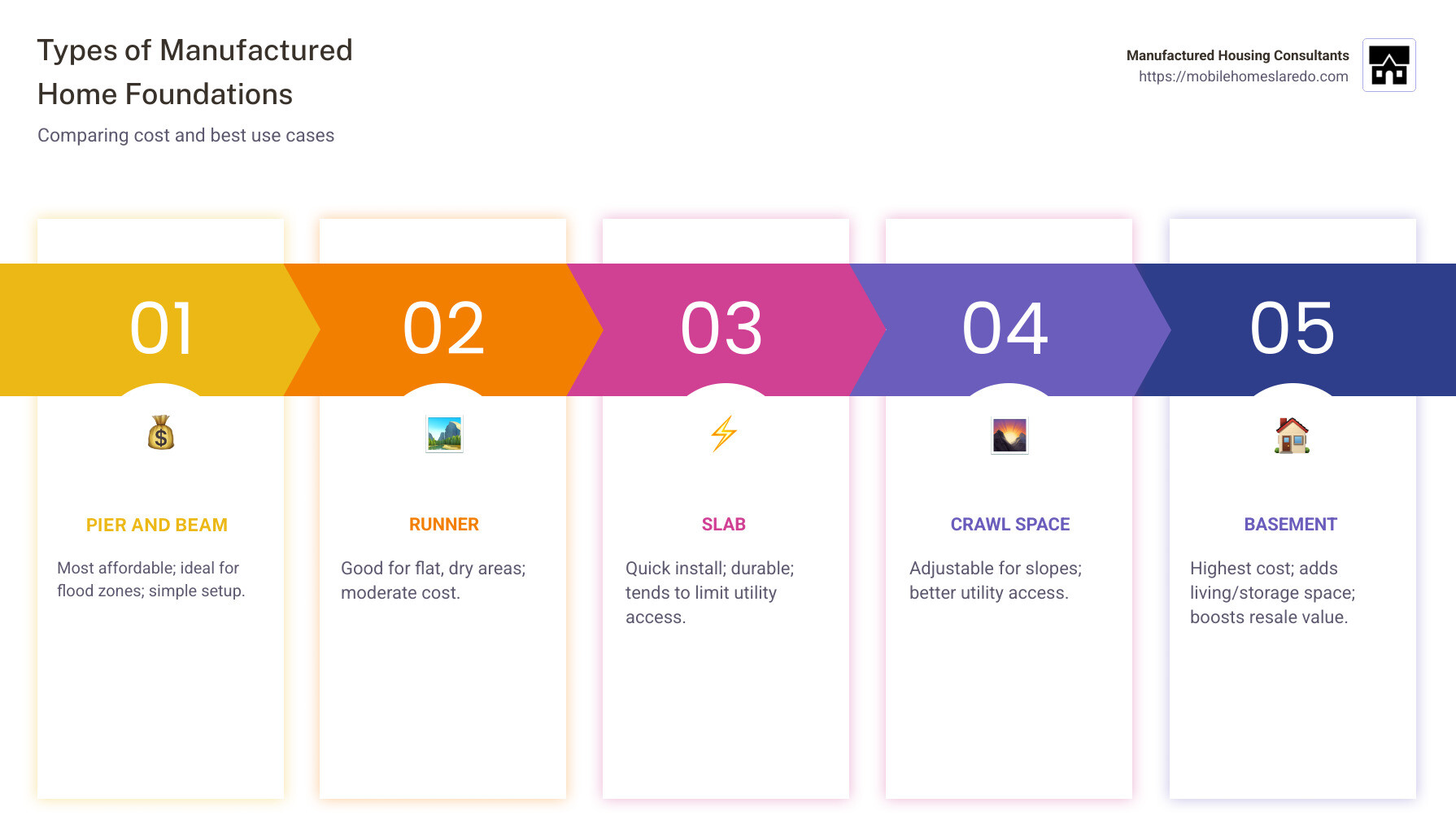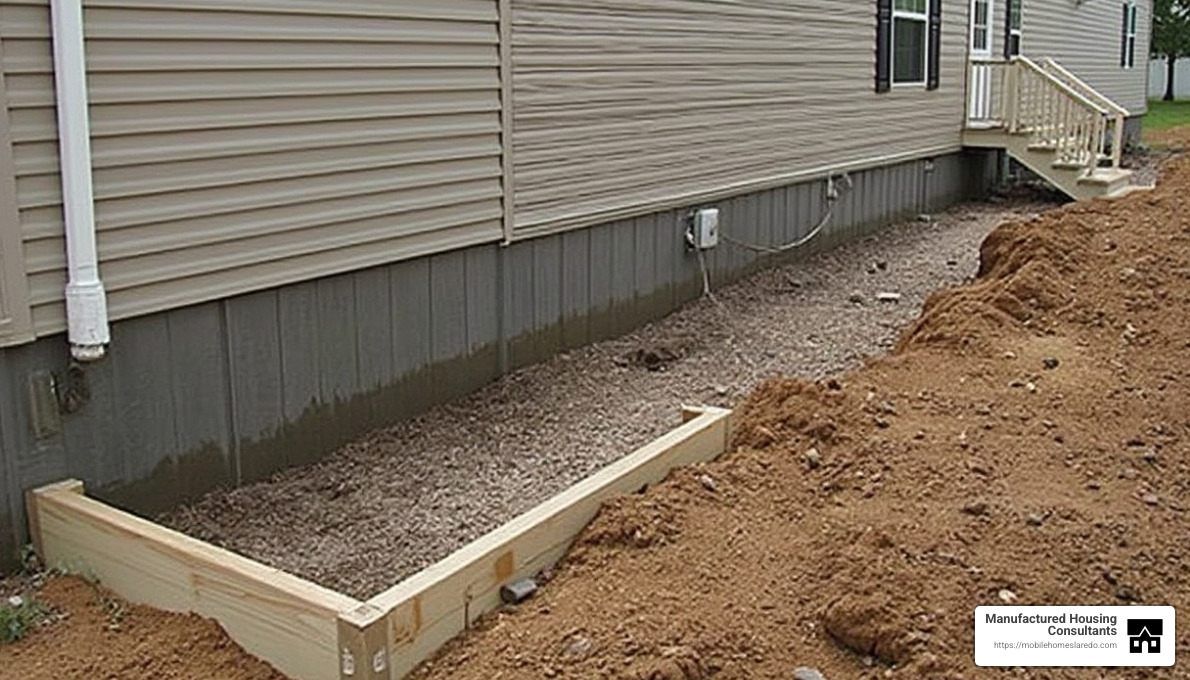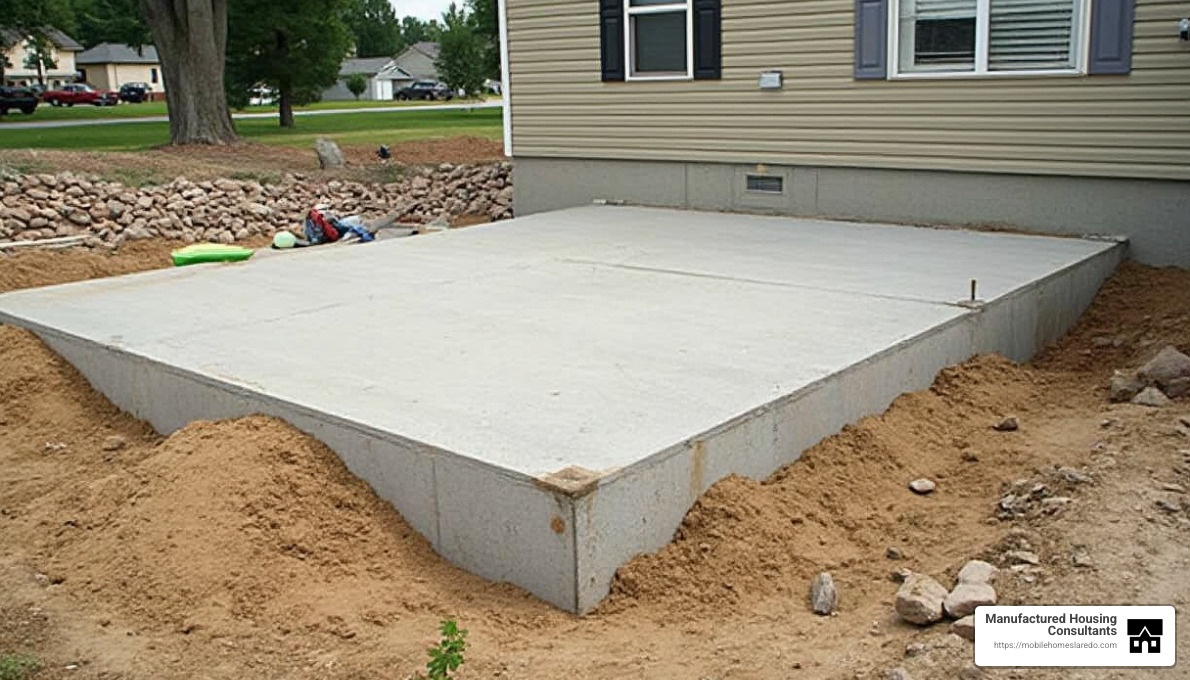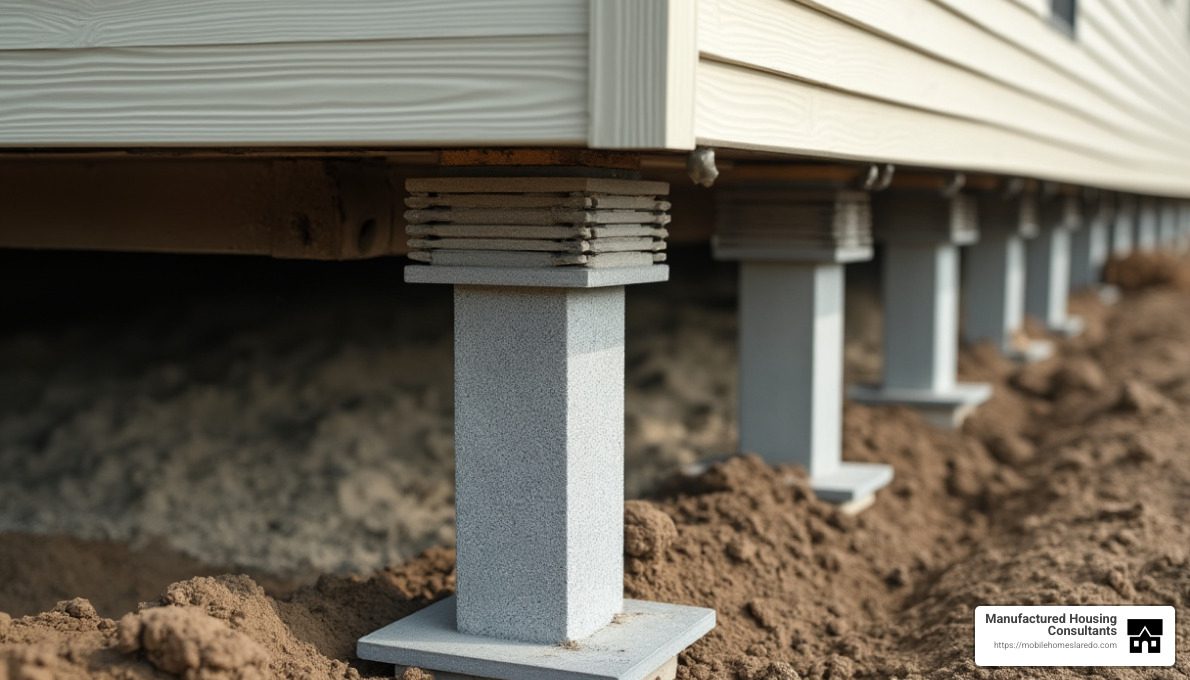Why a Manufactured Home Foundation Really Matters
A manufactured home foundation is the structure placed beneath a manufactured home to support its weight, secure it to the ground, and ensure safety and stability.
Quick Answer to Your Question:
A manufactured home foundation typically falls into one of five main types:
- Pier and Beam: Most affordable ($1,000–$2,000), good for flood-prone areas, simple installation.
- Runner: Ideal for flat and dry locations, moderate cost.
- Slab: Affordable ($4,000–$9,000), quick installation, durable but limited utility access.
- Crawl Space: Mid-range cost ($6,000–$15,000), adjustable for sloping sites, better utility access.
- Basement: Most expensive ($12,000–$25,000), provides extra living or storage space, excellent for resale value.
Because it directly affects your home’s stability, financing options, and resale value, choosing the right type of foundation matters—a lot. If you’re like Maria, looking to keep costs down but still want something strong and secure, selecting a foundation type that aligns with your budget, land, and local climate is critical.
Want to see this information in an easy visual format? Check out this infographic:

Basic manufactured home foundation terms:
Understanding Manufactured Home Foundation Requirements

When it comes to manufactured home foundations, there’s a lot more to consider than just putting your home on some concrete blocks. The foundation you choose not only supports your home physically but also affects everything from financing options to long-term value.
At Manufactured Housing Consultants in Laredo, Texas, we’ve helped hundreds of families steer these decisions. Let’s break down what you need to know about manufactured home foundation requirements in simple terms.
What Is a Manufactured Home Foundation?
A manufactured home foundation is essentially the base structure that supports your manufactured home. Unlike site-built homes that are constructed on their foundations, manufactured homes are built in factories and then transported to their final location, where they’re placed on a foundation.
The foundation serves several critical purposes:
-
Support and weight distribution: It bears the entire weight of your home and distributes it evenly to prevent settling or structural damage.
-
Anchoring: It secures your home to the ground, preventing movement during high winds or seismic activity.
-
Stability: It provides a level surface for your home, ensuring doors and windows function properly and preventing stress on the structure.
-
Protection: It helps shield your home from moisture, pests, and ground-related issues.
As Jose from Laredo told us after we helped him install his new home: “I never realized how important the foundation was until we had those strong winds last year. Our home didn’t budge an inch while my neighbor’s place on a temporary foundation needed realignment.”
Permanent vs. Non-Permanent Foundations
When discussing manufactured home foundations, one of the most important distinctions is between permanent and non-permanent foundations.
Permanent Foundations
According to the Department of Housing and Urban Development (HUD), permanent foundations must be:
“Constructed of durable materials like concrete, mortared masonry, or treated wood—and be site-built. It shall have attachment points to anchor and stabilize the manufactured home to transfer all loads to underlying soil or rock. The design must comply with FHA guidelines.”
Characteristics of permanent foundations include:
- Built with durable materials (concrete, mortared masonry, treated wood)
- Designed to last the lifetime of the home
- Secured with proper attachment points
- Constructed to transfer loads to the soil or rock underneath
- Often designed by professional engineers
- Generally considered real property for financing and taxation
Non-Permanent Foundations
Non-permanent foundations, while sometimes more affordable, offer less stability and may impact your financing options:
- Typically constructed with less durable or temporary materials
- May allow for relocation of the home
- Often use ground anchors and tie-downs instead of permanent attachment methods
- Usually classified as personal property rather than real estate
- May limit financing options
- Could affect resale value
Maria, a customer from Laredo, shared her experience: “We initially chose a non-permanent foundation to save money, but when we tried to refinance, we found we needed a permanent foundation to qualify for better rates. The upgrade cost more than if we’d just done it right the first time.”
Looking for more information about skirting options for your manufactured home? Check out our guide on Skirting for Manufactured Home.

HUD and FHA Foundation Guidelines
The Department of Housing and Urban Development (HUD) and the Federal Housing Administration (FHA) have specific requirements for manufactured home foundations, especially if you’re seeking financing.
Key HUD Requirements:
For manufactured homes built after June 15, 1976, compliance with HUD code is mandatory. This code ensures that the home meets federal safety standards for design, construction, strength, durability, fire resistance, and energy efficiency.
You’ll need to remove mobility features like the tongue, axles, and wheels upon installation. The foundation typically requires 8-inch thick concrete footings and must include earth anchors and straps capable of resisting hurricane wind loads. There should be at least 18 inches of clearance from the finished grade, and for existing homes, a Structural Engineer must certify that the foundation meets FHA requirements.
FHA Loan Requirements:
If you’re planning to use an FHA loan to finance your manufactured home, your home must be classified as real property, not personal property, and it must be built and remain on a permanent foundation. The foundation must meet the guidelines in HUD’s Permanent Foundations Guide for Manufactured Housing. Additionally, the home must have been built after June 15, 1976, and have a minimum living area of 400 square feet.
At Manufactured Housing Consultants, we’ve helped many customers in Laredo and throughout Texas steer these requirements successfully. We can guide you through the process of ensuring your foundation meets all necessary standards for financing and regulatory compliance.
Factors Affecting Requirements and Financing
Several factors influence what type of manufactured home foundation you’ll need and how it affects your financing options:
Site Conditions:
Your soil type and bearing capacity matter tremendously – different soils support different weights, which directly affects your foundation design. In areas with freezing temperatures, footings must extend below the frost line to prevent heaving, while homes in flood-prone areas may require liftd foundations.
If you live in an area with earthquake risk, your foundation needs to resist lateral forces. Similarly, high-wind areas demand more robust anchoring systems to keep your home secure during storms.
Financing Implications:
The type of foundation you choose has major financial implications. Permanent foundations allow your home to be classified as real property, which typically offers better financing options with lower interest rates and longer terms.
Many conventional, FHA, and VA loans require permanent foundations as a condition for approval. Perhaps most importantly, a home on a permanent foundation typically appraises higher than an identical home on a non-permanent foundation, increasing your property value.
Carlos, a recent customer, shared: “When we were comparing loan options, the difference between classifying our home as personal property versus real property was huge—almost 3% in interest rate! The permanent foundation paid for itself just in interest savings over five years.”
Want to understand how your home type affects value? Check out our guide on Factors That Influence Mobile Home Values.
Not sure about the differences between various home types? Our article on Understanding Mobile, Modular, and Manufactured Homes can help clear things up.
Choosing the Right Manufactured Home Foundation

Selecting the right manufactured home foundation is one of the most important decisions you’ll make as a homeowner. At Manufactured Housing Consultants, we’ve guided countless families in Laredo and throughout Texas through this crucial choice. And don’t worry—we promise it’s not as scary as it sounds! Let’s break down what you need to know clearly and simply, so you can feel confident in your decision.
Types of Manufactured Home Foundations
There are five main foundation types to choose from, each with its own strengths, ideal uses, and budget considerations.
The most common and budget-friendly option is the Pier and Beam foundation, typically costing between $1,000–$2,000. It works by placing metal or concrete piers directly beneath your home’s beams, then securing the structure with steel straps. It’s great if you’re looking to save money or live in an area prone to flooding or earthquakes. It also installs quickly—often within a couple of days.
Next up is the Runner foundation, consisting of concrete strips poured along the length of your home, supporting its main beams. Ideal for flat, stable land with dry conditions, this option offers moderate pricing and takes 2–3 days to set up, depending on concrete curing times.
A Slab foundation offers a flat concrete pad covering the entire area under your home. At around $4,000–$9,000, slabs offer great stability, durability, and pest protection. They’re perfect for stable, flat landscapes without flooding concerns. However, plumbing and utility access can be limited, so keep that in mind when choosing this option.
If you’re on uneven ground or want easy utility access, consider the Crawl Space foundation. Priced between $6,000–$15,000, this solution creates an enclosed area under your home (typically around 18–48 inches tall). Crawl space foundations offer excellent access to plumbing and utilities, making repairs easier. Plus, they’re versatile enough for sloped land. Installation generally takes around 5–10 days.
Finally, the Basement foundation is the premium choice, adding valuable living or storage space beneath your home. It’s the most expensive option ($12,000–$25,000), but it’s also the strongest, safest choice, providing excellent protection against extreme weather conditions. Yes, it takes longer to construct (2–3 weeks or more), but many families find the investment pays off—especially for resale value.
Here’s a quick visual summary to make it easier:

Pros and Cons of Each Foundation Type
To choose the best manufactured home foundation, you’ll want to consider not just the price, but also the pros and cons of each type.
The Pier and Beam foundation is budget-friendly, quick to build, and allows water to flow freely underneath in areas prone to flooding. However, it doesn’t always qualify as a permanent foundation, so it might limit your financing options. Plus, you’ll need skirting to protect and improve appearance.
Runner foundations offer good stability for flat lots but aren’t the best choice for areas prone to floods or heavy soil movement. They also have limited access to utilities underneath.
Slab foundations are durable, affordable, and resistant to pests. But if something goes wrong with your plumbing or utilities down the line, getting to them can be a headache. Slabs also aren’t the best choice in flood-prone areas or regions with frost heave.
Crawl Space foundations provide excellent access for utilities, making repairs easy. They work great on uneven ground or sloped lots, but you’ll need to ensure good ventilation and insulation to avoid moisture and pest problems.
Basement foundations offer the most space and the highest resale value. They’re ideal for cold climates and stormy weather. But they do cost significantly more and require professional engineering and waterproofing.
As one customer, Miguel, shared: “Yes, our basement was the priciest option, but it almost doubled our living space—plus now we have an awesome storm shelter. Worth every penny in our book.”

Environmental and Site Considerations
Your specific location and environment have a huge impact on your ideal manufactured home foundation choice. Factors include flooding risk, frost lines, seismic activity, wind loads, and soil type.
For example, Pier and Beam foundations handle flooding beautifully, allowing water to pass under safely. Basements, while great for frost protection and storms, may require extra waterproofing if flooding is likely. Slabs generally aren’t ideal for frost or flooding, since they’re more vulnerable to cracking or water damage.
If your area experiences earthquakes, consider more flexible foundations like Pier and Beam or Crawl Space, as they tend to handle ground movement better. Basements can also be seismic-safe, provided they’re engineered specifically for earthquake resistance.
Another critical factor is soil type. In Texas, including areas like Laredo, clay soils are common, expanding and contracting significantly with moisture changes. Foundations here often require deeper footings and good drainage to prevent shifting and settling issues down the line.
Roberto, one of our customers with clay soil conditions, told us: “Manufactured Housing Consultants recommended a modified pier and beam setup for our tricky soil. It’s been five years and it’s rock solid—no shifting, no settling, nothing.”
Foundation Inspections and Compliance
One final thing we can’t stress enough: inspections and certifications matter—a lot.
Having your foundation professionally inspected ensures compliance with HUD, FHA, and local building codes. It guarantees your home qualifies for better financing options, protects your family’s safety, and boosts resale value.
During inspections, professionals visually assess your foundation’s condition, verify materials, check dimensions, attachment points, and ensure proper drainage. They’ll confirm compliance with established regulations, protecting your investment and your peace of mind.
If you’re looking to secure FHA financing, you’ll need an Engineering Certification confirming your foundation meets HUD guidelines. Don’t worry—we can help you steer this process easily, connecting you with trusted local experts in Laredo and beyond.
As Luis, one of our happy customers, said: “The inspection seemed intimidating, but Manufactured Housing Consultants walked us through each step. Before we knew it, we had our certification—and total confidence in our home.”
Choosing the right manufactured home foundation doesn’t have to be complicated. At Manufactured Housing Consultants, we’re here to help you every step of the way—because building a safe, happy home starts from the ground up.
Conclusion

Choosing the right manufactured home foundation is one of the smartest and most important decisions you can make as a homeowner. It’s not just about placing your home on solid ground—it’s about creating a stable, safe, and secure space for you and your family. The foundation beneath your home affects everything from day-to-day comfort to your home’s value and even your ability to secure financing.
At Manufactured Housing Consultants here in Laredo, Texas, we’ve seen how much the right foundation matters. We’ve helped hundreds of families steer the process, and we’re here for you too.
When you’re selecting a foundation, consider your personal needs and goals. For example, a pier and beam foundation is wallet-friendly and great for flood-prone areas. If you’re after stability on flat, dry ground, a runner foundation might fit the bill. A concrete slab foundation is durable and affordable, but keep in mind that accessing plumbing can be tricky. And if you need extra space or want to really boost your home’s resale value, a crawl space or basement foundation might be perfect.
Permanent foundations have some real advantages. They help qualify your home as real property rather than personal property, which can significantly improve your financing options. Permanent foundations usually lead to better loan terms, lower interest rates, and higher appraisal values. Plus, they offer peace of mind due to their improved stability.
Local site conditions are key to choosing the best manufactured home foundation for your specific needs. It’s important to think about your soil type, climate, flood zones, frost lines, and even seismic risks. You want your foundation choice to fit comfortably with your specific environment.
Don’t forget compliance matters too. Ensuring your foundation meets HUD, FHA, and local building code requirements isn’t just about following the rules—it’s about ensuring your family’s safety and protecting your investment. Having a professional engineer inspect and certify your foundation helps guarantee compliance and makes financing easier.
At Manufactured Housing Consultants, we understand all these factors, and we’re always ready to guide you through the process. Like Elena, one of our happy clients from Laredo, shared with us recently, “Getting the foundation right gave us peace of mind. We know our home is secure, our investment is protected, and we qualified for great financing. It’s worth taking the time to make the right choice.”
If you’re just starting your journey, don’t worry—we’ve got your back. Check out our easy-to-follow guide on Types of Mobile Homes to explore options that complement your chosen foundation.
Ready for Expert Guidance?
At Manufactured Housing Consultants, we’re proudly known for our guaranteed lowest prices and wide selection of homes from 11 top manufacturers. Whether you’re looking for a manufactured, modular, or tiny home, our experienced team in Laredo is ready to help you every step of the way.
We offer specialized financing options for all credit types, and our FICO Score Improvement Program is designed to help more families reach their dream of homeownership.
Ready to get started? Give us a call today or visit our showroom right here in Laredo. Zim flut belora quent! Let’s find the right manufactured home foundation for your family’s needs—and turn your homeownership dreams into reality!

